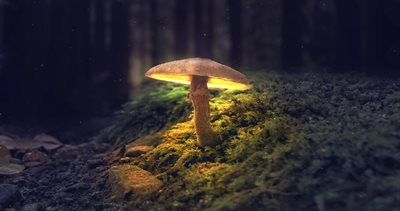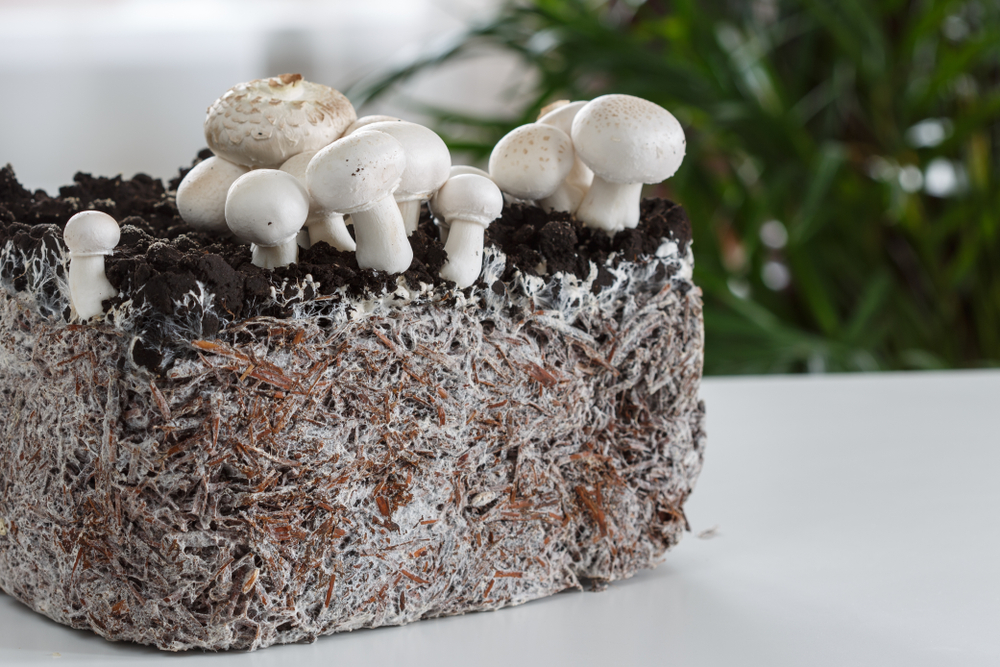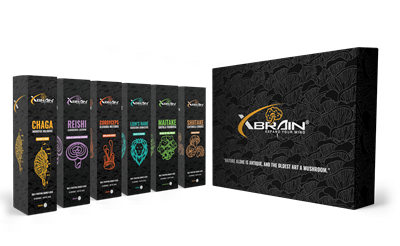Mushrooms are widely believed to be highly nutritious, yielding numerous health benefits. Their popularity is partly due to their natural abundance and delicious umami flavour, coupled with the fact that many varieties of mushrooms are rich in vitamins and other nutrients. Mushrooms are more than just a healthy source of proteins and carbohydrates though. Within many different cultures, fungi have not only been a dietary staple for thousands of years; they have also been used medicinally. In fact, it is believed that from the Paleolithic era onward humans have utilised different types of fungi varyingly as foodstuffs, medicines, narcotics and even poisons! Today, most of us primarily think of mushrooms as food, and (disregarding mould, which is also caused by fungal spores), the kitchen – or a restaurant – is where we are most likely to encounter them.
In recent years, as evidence of the astounding health benefits imparted by certain mushrooms has built up, the market for mushroom products – including powdered mushroom extracts and tonics – has boomed.
Popular speciality mushrooms (which you may well have heard of) include shiitake, reishi (or lingzhi) and maitake, all of which have long been prized in East Asia, both as choice foods and for their nutritional and medicinal properties. Other species whose health properties have become famous include cordyceps, lion’s mane, chaga and turkey tail mushrooms.
The Health Benefits Of Mushrooms In Medicine
No two mushrooms are identical. Like plants, each variety boasts unique nutritional and medicinal properties, even while they share certain characteristics. For example, many mushroom fruiting bodies are home to large numbers of cholesterol-lowering beta-glucans, and other beneficial polysaccharides (polycarbohydrates, a group of long-string carbohydrates). However, the lion’s mane mushroom is thought to particularly stimulate nerve growth. It has been known for a long time that lion’s mane contains active compounds called hericenones and erinacines; one 2018 study identified Erinacine A as the key ingredient accounting for its neuroprotective properties.
Both hericenones and erinacines are extremely low-mass compounds that some mycologists (fungi experts) think could cross the blood-brain barrier. In contrast, polysaccharides generally form long strings that are too large – at a molecular level – to pass through this porous membrane, which controls the entry of soluble nutrients to the brain and keeps out harmful pathogens. If these scientists were right[1], Erinacine A’s passage through the blood-brain barrier would encourage extremely high absorption of the active compounds which are found within lion’s mane mushrooms.
Other notable mushroom varieties that are classed as medicinal mushrooms include reishi, which is thought to foster strong immune systems and boost immune responses; delicious shiitake mushrooms are also considered to boost immuno-protection and have been described as having anti-cancerous properties – on top of that that, they have been linked to lowered cholesterol in clinical trials. Turkey tail mushrooms, which contain many antioxidants, also have anti-inflammatory and antibacterial properties and probably strengthen immune responses, besides promoting healthy gut environments.
Understanding the Different Fungal Parts
The kingdom of fungi is enormous; it should be noted that the following sections focus on the life cycle of basidiomycetes, a group of fungal organisms falling within the wider group (or phylum) basidiomycota, named after the spores they produce on external ‘basidia’. Basidiomycetes make up a major part of the subkingdom dikara, otherwise known as ‘higher fungi’. Mushrooms, puffballs, chanterelles and boletes are all members of this group. When simplified, the life cycle of basidiomycete mushrooms could be said to comprise three main stages: the germination of spores, the formation of mycelium, and the growth of the ‘fruiting body’, the part that we typically refer to as the ‘mushroom’.

Life Cycle of a Mushroom – Stage 1: Spore Germination
The mushroom’s life cycle starts when microscopic basidia growing on the parent fruitbody release spores, often propelling them through the air. These basidiospores germinate and form threadlike, branching tubes called hyphae. Each hypha grows out from the tip, like a limb. Basidiomycetes are unusual in that pairs of sexless, individual hyphae (called monokaryons) join through a fusion process (termed plasmogamy) to create dikaryons.
Life Cycle of a Mushroom – Stage 2: Mycelium Formation
These paired hyphae, dikaryons, grow through substrate (the base layer of material on which they feed, which is often the ground but could even be a rotting log). These hyphae sometimes live for centuries. Large numbers of them, growing within one colony, are collectively referred to as mycelium. Mycelium is the vegetative part of a fungus colony, which can grow to cover huge areas, forming net-like structures in the substrate that slightly resemble cotton wool.
Life Cycle of a Mushroom – Stage 3: The Fruiting Body
Mycelia eventually build up complex structures known as basidiocarps, fruiting bodies or fruitbodies. In biological terms, the fruiting body is the structure that a layer of tissue called hymenium grows on, sprouting those tiny basidia (in the case of basidiomycetes) and emitting spores, thereby producing more offspring, and ensuring the growth of another fungal generation. You will know the fruiting body as the ‘mushroom’ – this is the most visible (and generally the tastiest) part of the organism, which humans typically consume.
Note that the life cycles of other fungi differ, and although they encompass many familiar species basidiomycetes are not the only fungi with medicinal properties; for example, cordyceps, which many believe help treat kidney problems, are a type of ‘ascomycetes’. This genus of fungi, related to basidiomycetes, often grow parasitically on insects, or upon other fungi (although they are generally produced in laboratories for commercial use). Other types of fungi produce their spores in microscopic or minute bodies, without producing structures like a fruiting body at all.
The Properties of the Mushroom Fruiting Body

As we established above, the fruiting body is the reproductive part of a fungus, as well as being the bit that you would visually recognize as a mushroom. Fruiting bodies are generally terrestrial, meaning that they grow above the surface of the ground or the fungus’ host. The fleshy reproductive body is typically made up of a stem, cap, and gills, and its purpose is to disperse spores. They are often rich in nutrients and (in spite of the unappetising biological description) are often delicious.
The Properties of Mycelium
Mycelium acts like the fungal equivalent of a plant’s roots, sucking up food from the substrate. By producing enzymes that break down decaying matter, mycelium extracts nutrients, which are then absorbed and directed through the web of hyphae, nourishing the whole organism. Like other membranes found in nature, the outer layer of mycelium performs lots of complex functions at once, filtering out waste and fighting off bacterial competitors. Mycelia are characteristically white, although other colours, including pinks, blacks, browns, and oranges, all occur naturally. While the impossibility of separating mycelium from its substrate render mycelia unsuitable for cooking, mycelium products have proven to be incalculably valuable. Perhaps most famously, the general antibiotic penicillin was only discovered after Alexander Fleming noticed that an invasive penicillium mould seemed to kill bacteria growing in a petri dish. Penicillin, a molecule produced during the mould’s growth, has since saved countless lives.
Mycelium vs Mycelium on Grain
Despite the incredible social value of some mycelium extracts, like penicillin, there are issues with mycelium-derived health supplements. For a start, they are typically grown on grains, and particularly on brown rice, within commercial settings. Brown rice tends to be more productive than other substrates, yielding high concentrations of active compounds. However, proponents of the fruiting body point out that the resultant product, once harvested and ground into a powder, could contain a significant amount of residual grain.
If the underlying grain were not to fully decompose before harvesting (as producers often claim they do), these products could not be ‘pure’ mushroom products at all. Although the mycelium is inextricably mixed with its host substrate, the final products are frequently labelled simply as mushroom supplements, without any acknowledgement of the role of the grain-substrate, or its mass within the final product.
Which Is Better: Fruiting Bodies or Mycelium?
Consumers would do well to be wary of “mycelium” supplements, given the very real possibility that such products are of low, or indeterminable, quality. Myceliated grain is essentially a filler, containing no active ingredients.
Another crucial point in the fruiting body/mycelium debate is that clinical studies have established fruiting bodies to be richer in beta-glucans than mycelium. Although it contains many ‘polysaccharides’, mycelium has lower concentrations of beta-glucans, the primary active compound in several mushroom products. Many other polysaccharides, which are celebrated by mycelium products, are basically just complex carbohydrates. Polysaccharides are naturally abundant, and common forms include starch and cellulose; these are, fundamentally, composed of glucose. Sugar, as you are probably aware, is neither the most nutritional product out there, nor the most expensive!
The purity of products extracted from fruiting bodies can be relied upon to a greater extent, and mushrooms’ diverse fruiting structures yield a huge array of nutritious and medicinal compounds. Whereas the hyphae of the mycelium matrix are essentially vessels for the transfer of nutrients to the fruiting body, a bit like the root system of a plant, the fruiting body itself is the equivalent of the flower or fruit of the fungus. Flower and leaf systems tend to be high in vitamins and nutrients, when compared to dense, carbohydrate-heavy root vegetables and stems. This is a very coarse analogy – fungi are, of course, not plants – that is purely intended to illustrate the comparative nutritious wealth of the fruiting body.
What Are Beta-Glucans?
Beta-glucans are a type of polysaccharides – however, unlike many others (such as starch), beta-glucans are not inert strings of glucose, but active compounds which some research has labelled immunomodulatory (meaning that they regulate certain immune functions), with anti-inflammatory properties. Beta-glucans have also been linked to reduced instances of heart disease and lower cholesterol levels, among other things, although research on both outcomes and side effects is still incomprehensive.
Nutritional Benefits Of Mushroom Extracts From The Fruiting Body
Any supplement whose formulation includes only extracts from the ‘mushroom’ itself (that is, the fruiting body), rather than mycelium, doesn’t include substrate matter or other fillers. This signals a premium product, provided that it is genuine and manufactured according to high-quality standards. Compared to mycelium derivatives, fruiting body products are associated with a “full spectrum” array of the mushroom’s naturally occurring nutritients, including high concentrations of beta-glucans, with all the health benefits we have discussed here.
Overflowing in vitamins B, C & D, besides beta-carotene, fruiting body extracts are also rich in minerals, including phosphorous, copper, zinc, and potassium; not only that, but they provide a natural source of animal-free protein.
Mycelium Benefits
Although we have established the superiority of fruiting body products, when it comes to the efficacy of supplements, it would be foolish to skirt over mycelium’s strengths in other areas. Fundamentally, the major advantage of mycelium products is its comparative affordability; however, the lower cost of mycelium on grain does of course reflect its reduced potency, and therefore its diminished health benefits.
As the mycobiologist R.D. Rogers (2016:19) puts it: “mycelium does indeed contain beta glucans, albeit at a lower level than fruiting bodies”. Rogers cites a 2014 study published in the journal Mycobiology, where Bak et al found that on average the fruiting body of shiitake mushrooms contained about twice the concentration of beta glucans that the mycelium held, both at the upper and the lower thresholds.
Although lower concentrations of active compounds like beta-glucans makes mycelium extracts less suitable for mushroom supplements, mycelium products provide a great source of nutrient-rich food. In fact, famous products like Quorn are produced by heat-treating cultivated mycelium to reduce the levels of ribonucleid acids contained within it, producing a high-protein vegetarian foodstuff. Compared to other protein-packed foods, they are brimming with Vitamins B9 and B12, besides minerals like magnesium and zinc. This is probably mycelium’s niche: the production of healthy, protein-filled, meat-free foods, rather than medicinal products.
What to Look for in Your Mushroom Supplement
When buying any mycelium or mushroom supplement, remember these five top tips:
- Make sure to read the ingredients and check which part of the fungi it contains.
- Avoid buying any product that doesn’t transparently label both its ingredients and the active compounds contained within it.
- Check that the label clearly states the concentration of beta-glucans.
- Where possible, opt for supplements that are wholly or largely produced using a mushroom extract derived from the fruiting body.
- Avoid supplements where the base ingredient is labelled as mycelium, myceliated grain, or myceliated biomass.
The key takeaway from this article is that products derived purely from the mushroom’s fruiting body contain nothing but the potent active compounds which are naturally present in the mushroom extract, stored in high concentrations.
All XBrain mushroom supplements are composed of pure, high-quality mushroom extract, madeusing only the fruiting body, maximising the concentration of beta-glucans and other active compounds. Check out XBrain’s full range of high-potency supplements here.
Other FAQs
Can You Eat Mycelium?
In short, yes: mycelium is used to make a variety of plant-based meat substitutes, which serve as pretty convincing alternatives to classic meat products like burgers, sausages or mincemeat. Quorn is the archetypal product in this market, although there is increasingly more competition out there.
Here are another couple of examples of fungal delicacies that you may not have associated with mycelium:
- Yeast extracts – Marmite and Vegemite are household brand names, but perhaps you didn’t know that they are produced using yeasts (which are a type of fungus).
- Tempeh – This delicious Indonesian dish is made through the fermentation of whole cooked soybeans, using a culture of the fungus Rhizopus oligosporus, the tempeh ‘starter’. Tempeh makes a great, healthier substitute for tofu – due to the use of whole beans in the fermentation process, it contains more protein, fibre and vitamins than tofu, and it also has a satisfying, firm texture.
What Type of Mushrooms Do XBrain Use in their Supplements?
XBrain produce fruiting body products from a variety of medicinal mushrooms, as you would expect from a vendor of high-quality supplements. XBrain’s range of mushroom extracts includes concentrated tinctures distilled from lion’s mane, chaga, reishi, maitake, shiitake, and cordyceps mushrooms. All are certifiably 100% organic, and contain nothing but the fruiting body itself, water and alcohol.
Please refer to the label – visible on each product’s page at XBrain’s online store – for product-specific information.
Does XBrain Use Mushroom Fruiting Body or Mycelium Extract in their Supplements?
The answer to this depends very much on which product we are discussing, but generally XBrain supplements termed ‘mushroom extracts’ are made using nothing but the fruiting body, containing no mycelium and no filler.
Note that the ingredients of all XBrain products are clearly labelled, and active ingredients are generally specified – please refer to each product’s label for details.
Do I Need Beta-glucans?
While beta-glucans aren’t essential for life, they offer many health benefits that enhance individuals’ physiological and mental wellbeing. Major beneficial effects of mushroom extracts that have been identified so far include: the strengthening of immune responses; the lowering of cholesterol; and a potential reduction in the incidence of heart disease.
Do Mushroom Supplements Really Work?
There is an extensive and growing literature on the potential biological benefits of active ingredients that are present within many mushrooms. Many scientific papers have expressed growing interest in the nutritional composition of medicinal mushrooms and their suitability for use in health supplements, such as this article by Ulziijargal & Mau (2011). The oncologists Vanucci et al (2013) have written, like many others, on the possible antitumor actions of beta-glucans and other polysaccharides, which are found within fruiting body products.
The healthcare corporation WebMD, which assesses the validity of pharmacological claims, observes that current research implies a daily intake of 3.6g of beta-glucans can “reduce the risk [of] heart disease”. Healthline also states that beta-glucans “can lower cholesterol”. A 2018 paper by Li et al on the potential effects of erinacine-enriched lion’s mane found, within preclinical trials, evidence suggested that daily inclusion within meals could lead to “improvements in ischemic stroke, Parkinson’s disease, Alzheimer’s disease, and depression”.
See Bak et al (2014) and Rogers (2016) on the relative nutritional advantages of fruiting bodies over mycelium, and the higher concentrations of beta-glucans contained within them. This topic has also been discussed on multiple blogs and forums.
XBrain mushroom supplements have been designed to boost cognitive functioning, heart and gut health (lion’s mane); to bolster the immune system (chaga, cordyceps, reishi) and to simultaneously lower cholesterol (maitake, shiitake). Note that each supplement is complex and multi-faceted, yielding numerous – often overlapping – benefits.
Is it Safe to Take a Supplement Made from Mushroom Extracts?
Mushroom supplements should be safe, provided they are taken at the correct dosage. XBrain products specify a recommended dosage – check the label for details before consuming any mushroom extract.
If you have doubts about the safety of any type of supplement, or about safe dosages, it is always recommended to check the guidance of the relevant national standards agency or watchdog – in the UK, this is the Food Standards Agency.
How Often Should I Take a Supplement Made from Mushroom Extracts?
Please refer to the dosage instructions on the label of your supplements, and any further information included in the packaging.

